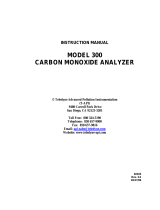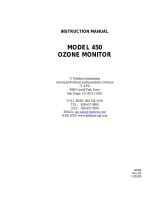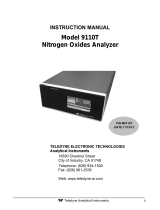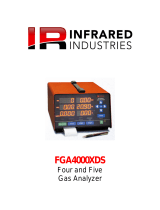Page is loading ...

INSTRUCTION MANUAL
MODEL 200AU
NITROGEN OXIDES ANALYZER
TELEDYNE INSTRUMENTS
ADVANCED POLLUTION INSTRUMENTATION DIVISION
(T-API)
6565 NANCY RIDGE DRIVE
SAN DIEGO, CA 92121-2251
TOLL-FREE: 800-324-5190
FAX: 858-657-9816
TEL: 858-657-9800
E-MAIL: [email protected]
WEB SITE: www.teledyne-api.com
02293
REV. F
Copyright 1999 API Inc.
07/06/99

Teledyne API Model 200AU NO
X
Analyzer Instruction Manual, 02293, Rev. F
ii
SAFETY MESSAGES
Your safety and the safety of others is very important. We have provided many important safety
messages in this manual. Please read these messages carefully.
A safety message alerts you to potential hazards that could hurt you or others. Each safety
message is associated with a safety alert symbol. These symbols are found in the manual and
inside the instrument. The definition of these symbols is described below:
GENERAL WARNING/CAUTION: Refer to the instructions for details on the
specific danger.
CAUTION: Hot Surface Warning
CAUTION: Electrical Shock Hazard
Technician Symbol: All operations marked with this symbol are to be performed
by qualified maintenance personnel only.
Electrical Ground: This symbol inside the instrument marks the central safety
grounding point for the instrument.
CAUTION
The analyzer should only be used for the purpose
and in the manner described in this manual.
If you use the analyzer in a manner other than that for which
it was intended, unpredictable behavior could ensue with
possible hazardous consequences.

Teledyne API Model 200AU NO
X
Analyzer Instruction Manual, 02293, Rev. F
iii
TABLE OF CONTENTS
SAFETY MESSAGES .........................................................................................II
TABLE OF CONTENTS .....................................................................................III
LIST OF FIGURES ........................................................................................... VII
LIST OF TABLES............................................................................................ VIII
1 HOW TO USE THIS MANUAL..................................................................... 1-1
2 GETTING STARTED.................................................................................... 2-1
2.1 U
NPACKING
....................................................................................................................2-1
2.2 E
LECTRICAL AND
P
NEUMATIC
C
ONNECTIONS
....................................................................2-1
2.3 I
NITIAL
O
PERATION
.........................................................................................................2-6
3 SPECIFICATIONS, AGENCY APPROVALS, WARRANTY ........................ 3-1
3.1 S
PECIFICATIONS
.............................................................................................................3-1
3.2 EPA E
QUIVALENCY
D
ESIGNATION
...................................................................................3-2
3.3 W
ARRANTY
....................................................................................................................3-3
4 THE M200AU NO
X
ANALYZER ................................................................... 4-1
4.1 P
RINCIPLE OF
O
PERATION
...............................................................................................4-1
4.2 O
PERATION
S
UMMARY
....................................................................................................4-3
4.2.1 Sensor Module, Reaction Cell, Detector................................................................4-3
4.2.2 Pneumatic Sensor Board.......................................................................................4-3
4.2.3 Computer Hardware and Software ........................................................................4-4
4.2.4 V/F Board ..............................................................................................................4-4
4.2.5 Front Panel............................................................................................................4-5
4.2.6 Power Supply Module............................................................................................4-7
4.2.7 Pump, Valves, Pneumatic System.........................................................................4-7
4.2.8 Ozone Generator...................................................................................................4-7
4.2.9 Molybdenum Converter – Ozone Scrubber ...........................................................4-8
5 SOFTWARE FEATURES............................................................................. 5-1
5.1 I
NDEX
T
O
F
RONT
P
ANEL
M
ENUS
......................................................................................5-1
5.1.1 Sample Menu ........................................................................................................5-4
5.1.2 Set-Up Menu .........................................................................................................5-6

Teledyne API Model 200AU NO
X
Analyzer Instruction Manual, 02293, Rev. F
iv
5.2 S
AMPLE
M
ODE
.............................................................................................................5-10
5.2.1 Test Functions .....................................................................................................5-10
5.2.2 CAL, CALS, CALZ, Calibration Functions............................................................5-13
5.3 S
ET
-U
P
M
ODE
.............................................................................................................5-16
5.3.1 Configuration Information (CFG) .........................................................................5-16
5.3.2 Automatic Calibration (AutoCal) ..........................................................................5-16
5.3.3 Data Acquisition System (DAS) ...........................................................................5-16
5.3.4 Range Menu........................................................................................................5-19
5.3.5 Password Enable.................................................................................................5-21
5.3.6 Time of Day Clock ...............................................................................................5-22
5.3.7 Diagnostic Mode..................................................................................................5-22
5.3.8 Communications Menu........................................................................................5-22
5.3.9 Variables Menu (VARS) ......................................................................................5-22
5.3.10 M200AU Operating Modes ................................................................................5-22
5.4 S
TATUS
O
UTPUT
..........................................................................................................5-23
5.5 RS-232 I
NTERFACE
......................................................................................................5-24
5.5.1 Setting Up the RS-232 Interface..........................................................................5-25
5.5.2 Command Summary............................................................................................5-28
5.5.3 TEST Commands and Messages........................................................................5-32
5.5.4 WARNING Commands and Messages................................................................5-33
5.5.5 CALIBRATION Commands and Messages .........................................................5-34
5.5.6 DIAGNOSTIC Commands and Messages...........................................................5-36
5.5.7 DAS Commands and Message ...........................................................................5-37
5.5.8 Internal Variables.................................................................................................5-39
6 OPTIONAL HARDWARE AND SOFTWARE............................................... 6-1
6.1 R
ACK
M
OUNT
O
PTIONS
...................................................................................................6-1
6.2 Z
ERO
/S
PAN
V
ALVES
.......................................................................................................6-1
6.3 A
UTOCAL
- S
ETUP
Z
ERO
/S
PAN
V
ALVES
............................................................................6-2
6.4 4-20
M
A, C
URRENT
L
OOP
O
UTPUT
..................................................................................6-4
6.5 NO
Y
C
ONVERTER
...........................................................................................................6-4
7 CALIBRATION & ZERO/SPAN CHECKS ................................................... 7-1
7.1 M
ANUAL
Z
ERO
/S
PAN
C
HECK OR
C
AL WITH
Z
ERO
/S
PAN
G
AS IN THE
S
AMPLE
P
ORT
..............7-4
7.2 M
ANUAL
Z
ERO
/S
PAN
C
HECK OR
C
ALIBRATION WITH
Z
ERO
/S
PAN
V
ALVES
O
PTION
...............7-6
7.3 A
UTOMATIC
Z
ERO
/S
PAN
C
HECK
......................................................................................7-7
7.4 D
YNAMIC
Z
ERO
/S
PAN
C
ALIBRATION
.................................................................................7-7
7.5 U
SE OF
Z
ERO
/S
PAN
V
ALVES WITH
R
EMOTE
C
ONTACT
C
LOSURE
........................................7-8
7.6 EPA P
ROTOCOL
C
ALIBRATION
........................................................................................7-9
7.6.1 Calibration of Equipment .......................................................................................7-9
7.6.2 Calibration Gas and Zero Air Sources .................................................................7-11
7.6.3 Data Recording Device........................................................................................7-12
7.6.4 Gas Phase Titration (GPT) System .....................................................................7-12

Teledyne API Model 200AU NO
X
Analyzer Instruction Manual, 02293, Rev. F
v
7.6.5 Dynamic Multipoint Calibration Procedure...........................................................7-16
7.6.6 Moly Converter Efficiency....................................................................................7-23
7.6.7 Calibration Frequency .........................................................................................7-25
7.6.8 Other Quality Assurance Procedures ..................................................................7-25
7.6.9 Summary of Quality Assurance Checks ..............................................................7-27
7.6.10 ZERO and SPAN Checks..................................................................................7-29
7.6.11 Recommended Standards for Establishing Traceability ....................................7-30
7.6.12 Certification Procedures of Working Standards .................................................7-31
7.7 C
ALIBRATION OF
I
NDEPENDENT
R
ANGES OR
A
UTORANGING
.............................................7-32
7.7.1 Zero Calibration with AutoRange or Independent Range ....................................7-32
7.7.2 Span Calibration with AutoRange or Independent Range ...................................7-33
7.8 C
ALIBRATION
Q
UALITY
..................................................................................................7-33
7.9 R
EFERENCES
...............................................................................................................7-35
8 MAINTENANCE ........................................................................................... 8-1
8.1 M
AINTENANCE
S
CHEDULE
...............................................................................................8-1
8.2 R
EPLACING THE
S
AMPLE
P
ARTICULATE
F
ILTER
.................................................................8-3
8.3 S
AMPLE
P
UMP
M
AINTENANCE
..........................................................................................8-5
8.4 C
LEANING THE
R
EACTION
C
ELL
.......................................................................................8-7
8.5 R
EPLACING THE
M
OLYBDENUM
C
ONVERTER
.....................................................................8-9
8.6 P
NEUMATIC
L
INE
I
NSPECTION
........................................................................................8-11
8.7 L
EAK
C
HECK
P
ROCEDURE
.............................................................................................8-15
8.8 L
IGHT
L
EAK
C
HECK
P
ROCEDURE
...................................................................................8-16
8.9 P
ROM
R
EPLACEMENT
P
ROCEDURE
................................................................................8-16
9 TROUBLESHOOTING, ADJUSTMENTS .................................................... 9-1
9.1 O
PERATION
V
ERIFICATION
-M200AU D
IAGNOSTIC
T
ECHNIQUES
.........................................9-3
9.1.1 Fault Diagnosis with TEST Variables ....................................................................9-3
9.1.2 Fault Diagnosis with WARNING Messages...........................................................9-8
9.1.3 Fault Diagnosis using DIAGNOSTIC Mode .........................................................9-11
9.1.4 M200AU Internal Variables..................................................................................9-19
9.1.5 Test Channel Analog Output ...............................................................................9-21
9.1.6 Factory Calibration Procedure .............................................................................9-23
9.2 P
ERFORMANCE
P
ROBLEMS
............................................................................................9-26
9.2.1 AC Power Check .................................................................................................9-26
9.2.2 Flow Check..........................................................................................................9-27
9.2.3 No Response to Sample Gas ..............................................................................9-27
9.2.4 Negative Output...................................................................................................9-28
9.2.5 Excessive Noise ..................................................................................................9-28
9.2.6 Unstable Span .....................................................................................................9-29
9.2.7 Unstable Zero ......................................................................................................9-30
9.2.8 Inability to Span ...................................................................................................9-30
9.2.9 Inability to Zero ....................................................................................................9-31

Teledyne API Model 200AU NO
X
Analyzer Instruction Manual, 02293, Rev. F
vi
9.2.10 Non-Linear Response........................................................................................9-31
9.2.11 Slow Response..................................................................................................9-32
9.2.12 Analog Output Doesn't Agree with Display Concentration.................................9-32
9.3 S
UBSYSTEM
T
ROUBLESHOOTING AND
A
DJUSTMENTS
.......................................................9-32
9.3.1 Computer, Display, Keyboard..............................................................................9-32
9.3.2 RS-232 Communications.....................................................................................9-36
9.3.3 Voltage/Frequency (V/F) Board ...........................................................................9-39
9.3.4 Status/Temp Board..............................................................................................9-45
9.3.5 Power Supply Module..........................................................................................9-47
9.3.6 Ozone Generator.................................................................................................9-52
9.3.7 Flow/Pressure Sensor .........................................................................................9-55
9.3.8 NO
x
Sensor Module.............................................................................................9-60
9.3.9 Z/S Valves ...........................................................................................................9-64
9.3.10 Pneumatic System.............................................................................................9-65
10 M200AU SPARE PARTS LIST ................................................................ 10-1
APPENDIX A ELECTRICAL SCHEMATICS ..................................................A-1

Teledyne API Model 200AU NO
X
Analyzer Instruction Manual, 02293, Rev. F
vii
LIST OF FIGURES
F
IGURE
2-1: R
EMOVAL OF
S
HIPPING
S
CREWS
& C
HECK FOR
C
ORRECT
P
OWER
..........................2-3
F
IGURE
2-2: R
EAR
P
ANEL
........................................................................................................2-4
F
IGURE
2-3: I
NLET AND
E
XHAUST
V
ENTING
...............................................................................2-5
F
IGURE
2-4: F
RONT
P
ANEL
....................................................................................................2-10
F
IGURE
2-5: A
SSEMBLY
L
AYOUT
............................................................................................2-11
F
IGURE
4-1: B
LOCK
D
IAGRAM
..................................................................................................4-2
F
IGURE
5-1: S
AMPLE
M
ENU
T
REE
............................................................................................5-2
F
IGURE
5-2: S
ETUP
M
ENU
T
REE
..............................................................................................5-3
F
IGURE
7-1: C
ALIBRATION
S
ETUP
............................................................................................7-3
F
IGURE
7-2: D
IAGRAM OF
GPT C
ALIBRATION
S
YSTEM
.............................................................7-18
F
IGURE
8-1: R
EPLACING THE
P
ARTICULATE
F
ILTER
...................................................................8-4
F
IGURE
8-2: S
AMPLE
P
UMP
A
SSEMBLY
.....................................................................................8-6
F
IGURE
8-3: R
EACTION
C
ELL
A
SSEMBLY
..................................................................................8-8
F
IGURE
8-4: M
OLYBDENUM
C
ONVERTER
A
SSEMBLY
................................................................8-10
F
IGURE
8-5: P
NEUMATIC
D
IAGRAM
- S
TANDARD
C
ONFIGURATION
.............................................8-12
F
IGURE
8-6: P
NEUMATIC
D
IAGRAM WITH
Z
ERO
/S
PAN
V
ALVE
O
PTION
........................................8-13
F
IGURE
8-7: P
NEUMATIC
D
IAGRAM WITH
E
XTERNAL
C
ONVERTER
O
PTION
.................................8-14
F
IGURE
9-1: S
PAN
C
ALIBRATION
V
OLTAGE
.............................................................................9-25
F
IGURE
9-2: CPU B
OARD
J
UMPER
S
ETTINGS
.........................................................................9-34
F
IGURE
9-3: RS-232 PIN A
SSIGNMENTS
...............................................................................9-38
F
IGURE
9-4: V/F B
OARD
S
ETTINGS
........................................................................................9-44
F
IGURE
9-5: P
OWER
S
UPPLY
M
ODULE
L
AYOUT
.......................................................................9-49
F
IGURE
9-6: E
LECTRICAL
B
LOCK
D
IAGRAM
.............................................................................9-50
F
IGURE
9-7: O
ZONE
G
ENERATOR
S
UBSYSTEM
........................................................................9-54
F
IGURE
9-8: F
LOW
/P
RESSURE
S
ENSOR
..................................................................................9-57
F
IGURE
9-9: NO
X
S
ENSOR
M
ODULE
.......................................................................................9-58
F
IGURE
9-10: NO
X
S
ENSOR
M
ODULE
.....................................................................................9-59
F
IGURE
9-11: PMT C
OOLER
S
UBSYSTEM
...............................................................................9-61
F
IGURE
9-12: H
IGH
V
OLTAGE
P
OWER
S
UPPLY
........................................................................9-63

Teledyne API Model 200AU NO
X
Analyzer Instruction Manual, 02293, Rev. F
viii
LIST OF TABLES
T
ABLE
2-1: F
INAL
T
EST AND
C
ALIBRATION
V
ALUES
..................................................................2-12
T
ABLE
2-1: F
INAL
T
EST AND
C
ALIBRATION
V
ALUES
(C
ONTINUED
) .............................................2-13
T
ABLE
4-1: F
RONT
P
ANEL
S
TATUS
LED'
S
.................................................................................4-6
T
ABLE
4-2:
O
ZONE
G
ENERATOR
S
TART
-
UP
T
IMING
....................................................................4-8
T
ABLE
5-1: S
AMPLE
M
ENU
......................................................................................................5-4
T
ABLE
5-2: S
AMPLE
M
ENU
......................................................................................................5-5
T
ABLE
5-3: S
ETUP
M
ENU
.........................................................................................................5-6
T
ABLE
5-3: S
ETUP
M
ENU
(C
ONTINUED
) ....................................................................................5-7
T
ABLE
5-4: S
ETUP
M
ENU
.........................................................................................................5-8
T
ABLE
5-5: S
ETUP
M
ENU
.........................................................................................................5-9
T
ABLE
5-6: DAS D
ATA
C
HANNEL
E
DITING
..............................................................................5-19
T
ABLE
5-7: C
ALIBRATE
, S
ETUP
P
ASSWORDS
..........................................................................5-21
T
ABLE
5-8: M200AU O
PERATING
M
ODES
..............................................................................5-23
T
ABLE
5-9: S
TATUS
O
UTPUT
P
IN
A
SSIGNMENTS
......................................................................5-24
T
ABLE
5-10: RS-232 P
ORT
S
ETUP
- F
RONT
P
ANEL
................................................................5-25
T
ABLE
5-11: RS-232 S
WITCHING
F
ROM
T
ERMINAL
M
ODE TO
C
OMPUTER
M
ODE
.......................5-27
T
ABLE
5-12: RS-232 T
ERMINAL
M
ODE
E
DITING
K
EYS
.............................................................5-27
T
ABLE
5-13: RS-232 C
OMMAND
S
UMMARY
............................................................................5-29
T
ABLE
5-14: RS-232 C
OMMAND
S
UMMARY
............................................................................5-30
T
ABLE
5-15: RS-232 I
NTERFACE
C
OMMAND
T
YPES
................................................................5-31
T
ABLE
5-16: RS-232 T
EST
M
ESSAGES
..................................................................................5-32
T
ABLE
5-17: RS-232 W
ARNING
M
ESSAGES
...........................................................................5-33
T
ABLE
5-18: RS-232 C
ALIBRATION
C
OMMANDS
......................................................................5-34
T
ABLE
5-19: RS-232 C
ALIBRATION
E
XAMPLES
.......................................................................5-35
T
ABLE
5-20: RS-232 C
ALIBRATION
M
ESSAGES
......................................................................5-36
T
ABLE
5-21: RS-232 D
IAGNOSTIC
C
OMMAND
S
UMMARY
.........................................................5-37
T
ABLE
6-1: Z
ERO
/S
PAN
V
ALVE
O
PERATION
..............................................................................6-1
T
ABLE
6-2: E
XAMPLE OF
A
UTO
C
AL
S
ETUP
................................................................................6-4
T
ABLE
7-1: T
YPES OF
Z
ERO
/S
PAN
C
HECK AND
C
ALIBRATION
.....................................................7-2
T
ABLE
7-2: M
ANUAL
Z
ERO
C
ALIBRATION
P
ROCEDURE
- Z
ERO
G
AS THRU
S
AMPLE
P
ORT
..............7-4
T
ABLE
7-3: E
NTER
E
XPECTED
S
PAN
G
AS
C
ONCENTRATIONS
P
ROCEDURE
..................................7-5
T
ABLE
7-4: M
ANUAL
S
PAN
C
ALIBRATION
P
ROCEDURE
- S
PAN
G
AS THRU
S
AMPLE
P
ORT
..............7-5
T
ABLE
7-5: M
ANUAL
Z
ERO
C
ALIBRATION
P
ROCEDURE
- Z/S V
ALVES
..........................................7-6
T
ABLE
7-6: M
ANUAL
S
PAN
C
ALIBRATION
P
ROCEDURE
- Z/S V
ALVES
..........................................7-7
T
ABLE
7-7: E
NABLING
D
YNAMIC
Z
ERO
/S
PAN
.............................................................................7-8
T
ABLE
7-8: Z/S V
ALVES
M
ODES WITH
R
EMOTE
C
ONTACT
C
LOSURE
...........................................7-9
T
ABLE
7-9: A
CTIVITY
M
ATRIX FOR
C
ALIBRATION
E
QUIPMENT AND
S
UPPLIES
..............................7-10
T
ABLE
7-10: A
CTIVITY
M
ATRIX FOR
C
ALIBRATION
P
ROCEDURE
.................................................7-11
T
ABLE
7-11: Z
ERO
C
ALIBRATION
P
ROCEDURE
........................................................................7-19
T
ABLE
7-12: E
XPECTED
S
PAN
G
AS
C
ONCENTRATION
P
ROCEDURE
...........................................7-20

Teledyne API Model 200AU NO
X
Analyzer Instruction Manual, 02293, Rev. F
ix
T
ABLE
7-13: S
PAN
C
ALIBRATION
P
ROCEDURE
.........................................................................7-20
T
ABLE
7-14: A
UTOMATIC
C
ALCULATION OF
C
ONVERTER
E
FFICIENCY
........................................7-24
T
ABLE
7-15: D
EFINITION OF
L
EVEL
1
AND
L
EVEL
2 Z
ERO AND
S
PAN
C
HECKS
............................7-26
T
ABLE
7-16: A
CTIVITY
M
ATRIX FOR
D
ATA
Q
UALITY
..................................................................7-28
T
ABLE
7-17: NIST-SRM'
S
A
VAILABLE FOR
T
RACEABILITY OF
C
ALIBRATION AND
A
UDIT
G
AS
S
TANDARDS
........................................................................................................................7-31
T
ABLE
7-18: C
ALIBRATION
Q
UALITY
C
HECK
............................................................................7-34
T
ABLE
8-1: P
REVENTATIVE
M
AINTENANCE
S
CHEDULE
................................................................8-1
T
ABLE
8-2: P
REVENTATIVE
M
AINTENANCE
C
ALENDAR
...............................................................8-2
T
ABLE
9-1: T
EST
F
UNCTIONS
...................................................................................................9-4
T
ABLE
9-1: T
EST
F
UNCTIONS
(C
ONTINUED
) ..............................................................................9-5
T
ABLE
9-1: T
EST
F
UNCTIONS
(C
ONTINUED
) ..............................................................................9-6
T
ABLE
9-1: T
EST
F
UNCTIONS
(C
ONTINUED
) ..............................................................................9-7
T
ABLE
9-2: F
RONT
P
ANEL
W
ARNING
M
ESSAGES
.......................................................................9-9
T
ABLE
9-2: F
RONT
P
ANEL
W
ARNING
M
ESSAGES
(C
ONTINUED
).................................................9-10
T
ABLE
9-3: S
UMMARY OF
D
IAGNOSTIC
M
ODES
........................................................................9-12
T
ABLE
9-4: D
IAGNOSTIC
M
ODE
- S
IGNAL
I/O...........................................................................9-13
T
ABLE
9-4: D
IAGNOSTIC
M
ODE
- S
IGNAL
I/O (C
ONTINUED
) ......................................................9-14
T
ABLE
9-4: D
IAGNOSTIC
M
ODE
- S
IGNAL
I/O (C
ONTINUED
) ......................................................9-15
T
ABLE
9-4: D
IAGNOSTIC
M
ODE
- S
IGNAL
I/O (C
ONTINUED
) ......................................................9-16
T
ABLE
9-5: M
ODEL
200AU V
ARIABLES
...................................................................................9-20
T
ABLE
9-6: T
EST
C
HANNEL
R
EADINGS
....................................................................................9-21
T
ABLE
9-6: T
EST
C
HANNEL
R
EADINGS
(C
ONTINUED
) ...............................................................9-22
T
ABLE
9-7: M
OTHERBOARD
J
UMPER
S
ETTINGS
.......................................................................9-41
T
ABLE
9-8: V/F B
OARD
S
WITCH
S
ETTINGS
.............................................................................9-42
T
ABLE
9-9: P
OWER
S
UPPLY
M
ODULE
S
UBASSEMBLIES
............................................................9-48
T
ABLE
9-10: P
OWER
S
UPPLY
M
ODULE
LED O
PERATION
.........................................................9-51
T
ABLE
9-11: O
ZONE
G
ENERATOR
C
ONTROL
C
ONDITIONS
........................................................9-53
T
ABLE
10-1: TELEDYNE API M200AU S
PARE
P
ARTS
L
IST
...................................................10-1
T
ABLE
10-1: TELEDYNE API M200AU S
PARE
P
ARTS
L
IST
(C
ONTINUED
) ..............................10-2
T
ABLE
10-2: TELEDYNE API MODEL 200AU E
XPENDABLE
K
IT
...........................................10-3
T
ABLE
A-1: E
LECTRICAL
S
CHEMATICS
..................................................................................... A-1

Teledyne API Model 200AU NO
X
Analyzer Instruction Manual, 02293, Rev. F
x
INTENTIONALLY BLANK

Teledyne API Model 200AU NO
X
Analyzer Instruction Manual, 02293, Rev. F
1-1
1 HOW TO USE THIS MANUAL
The Model 200AU has been designed to provide serviceability, reliability and ease of operation.
The M200AU’s microprocessor continually checks operating parameters such as temperature,
flow, and critical voltages. The instrument’s modular design uses captive screws to facilitate
repair and ease of access. If you encounter any difficulty refer to Section 9 General
Troubleshooting Hints.
We recognize that the need for information in this manual changes as time passes. When the
instrument first arrives, it is necessary to get it up and running quickly and verify its correct
operation. As time passes, more detailed information is often required on special configurations,
calibration alternatives and other operational details. Finally there is the need for periodic
maintenance and to quickly troubleshoot problems to assure maximum reliability and data
integrity.
To address these needs, we have created three indexes to the information inside. They are:
Table of Contents:
Outlines the contents of the manual in the order the information is presented. This is a good
overview of the topics covered in the manual. There is also a list of Tables and a list of Figures.
Index to M200AU Front Panel Menus:
The Menu Index (Figure 5-1, Figure 5-2, Table 5-1 and Table 5-2) briefly describes the front
panel menus and refers you to other sections of the manual that have a detailed explanation of
each menu selection.
Troubleshooting Section 9:
The Troubleshooting Section, outlined in the Table of Contents, allows you to diagnose and
repair the instrument based on variables in the TEST menu, the results of DIAGNOSTIC tests,
and performance faults such as excessive noise or drift. The troubleshooting section also
explains the operation, adjustment, diagnosis and testing of each instrument subsystem.
If you are unpacking the instrument for the first time, please refer to Getting Started in
Section 2.

Teledyne API Model 200AU NO
X
Analyzer Instruction Manual, 02293, Rev. F
1-2
INTENTIONALLY BLANK

Teledyne API Model 200AU NO
X
Analyzer Instruction Manual, 02293, Rev. F
2-1
2 GETTING STARTED
2.1 Unpacking
1. Verify that there is no apparent shipping damage. If damage has occurred please advise
shipper first, then Teledyne API.
CAUTION
To avoid personal injury, always use two persons to
lift and carry the Model 200AU.
2. Before operation, it is necessary to remove the shipping hold-down screws. Remove the
instrument cover, then refer to Figure 2-1 for screw location.
3. Also check for internal shipping damage, and generally inspect the interior of the
instrument to make sure all circuit boards and other components are in good shape.
4. Please check the voltage and frequency label on the rear panel of the instrument for
compatibility with the local power before plugging in the M200AU.
2.2 Electrical and Pneumatic Connections
Refer to Figure 2-2 to locate the rear panel electrical and pneumatic connections.
1. Attach the pump to the Exhaust Out port on the instrument rear panel.
2. If you are connecting to a calibrator, attach a vented sample inlet line to the sample inlet
port. The pressure of the sample gas at the inlet port should be at ambient pressure. The
exhaust from the pump should be vented to atmospheric pressure. See Figure 2-3 for inlet
and exhaust line venting recommendations during calibration.
3. If desired, attach the analog output connections to a strip chart recorder and/or
datalogger. Refer to Figure 9-4 for the jumper settings for the desired analog output voltage
range. Factory default setting is 0-5VDC.
4. Connect the power cord to the correct voltage line, then turn to Section 2.3 Initial
Operation.

Teledyne API Model 200AU NO
X
Analyzer Instruction Manual, 02293, Rev. F
2-2
WARNING
Analyzer Exhaust –Sample Pump
For brief periods after power-up, analyzer
exhaust may contain ozone.
Make sure pump exhaust is routed to well ventilated
area at atmospheric pressure.
WARNING
Lethal voltages present inside case.
Do not operate with cover off during normal operation.
Before operation check for correct input voltage and frequency for
both the analyzer and the sample pump.
Do not operate without proper chassis grounding.
Do not defeat the ground wire on power plug.
Turn off analyzer power before disconnecting
electrical subassemblies.

Teledyne API Model 200AU NO
X
Analyzer Instruction Manual, 02293, Rev. F
2-3
Figure 2-1: Removal of Shipping Screws & Check for Correct Power

Teledyne API Model 200AU NO
X
Analyzer Instruction Manual, 02293, Rev. F
2-4
Figure 2-2: Rear Panel

Teledyne API Model 200AU NO
X
Analyzer Instruction Manual, 02293, Rev. F
2-5
Figure 2-3: Inlet and Exhaust Venting

Teledyne API Model 200AU NO
X
Analyzer Instruction Manual, 02293, Rev. F
2-6
2.3 Initial Operation
1. After confirming proper supply voltage, turn on the instrument power.
2. The display should immediately light, displaying the instrument type (M200AU) and the
computer's memory configuration. If you are unfamiliar with the M200AU, we recommend
that you read the overview Section 4 before proceeding. A diagram of the software menu
trees is in Figure 5-1 and Figure 5-2.
3. The M200AU requires about 30 minutes for all internal components to come up to
temperature. During this time the ozone generator power is OFF until the membrane dryer
has time to purge itself, therefore there will be no response from the instrument, even if span
gas is coming in the sample port. During this time temperatures and other conditions are out
of specification. Because many warning conditions could be displayed the software
suppresses warning conditions for 30 minutes after power up. After 30 minutes, warning
messages will be displayed until the respective warning conditions are within specifications.
Use the CLR key on the front panel to clear warning messages.
4. While waiting for instrument temperatures to come up, you can check for correct
operation by using some of the M200AU's diagnostic and test features.
5. Examine the TEST functions by comparing the values listed in Table 2-1 to those in the
display. Remember that as the instrument warms up the values may not have reached their
final values yet. If you would like to know more about the meaning and utility of each TEST
function, refer to Table 9-1. Also, now is a good time to verify that the instrument was
shipped with the options you ordered. Table 2-1 also contains the list of options. Section 6
covers setting up the options.
6. When the instrument is warmed up, re-check the TEST functions against Table 2-1. All
of the readings should compare closely with those in the Table. If they do not, see Section
9.1.1. The next task is to calibrate the analyzer. There are several ways to do a calibration,
they are summarized in Table 7-1. For instruments not equipped with the external converter
option, we recommend calibration with zero air and span gas coming in through the sample
port. The procedure is:

Teledyne API Model 200AU NO
X
Analyzer Instruction Manual, 02293, Rev. F
2-7
Step 1 - Enter the expected NO
x
and NO span gas concentrations:
Step Number Action Comment
1. Press
CAL-CONC-NOX
This key sequence causes the M200AU to prompt for the
expected NO
x
concentration. Enter the NO
x
span
concentration value by pressing the key under each digit until
the expected value is set.
2. Press ENTR ENTR stores the expected NO
x
span value. This value will be
used in the internal formulas to compute subsequent NO
x
concentration values.
3. Press
CAL-CONC-NO
In the same CAL-CONC sub menu press the NO button and
enter the expected NO span value, then ENTR. As before this
value will be used in the internal formulas to compute the
subsequent NO concentration values.
4. Press EXIT-EXIT Returns instrument to SAMPLE mode.
5. Press
SETUP-RNGE-
MODE-SING-ENTR
If necessary, you may want to change ranges. Normally the
instrument is shipped in single range mode set at 500 ppb. We
recommend doing the initial checkout on the 500 ppb range.
6. Press
SETUP-RNGE-SET
After SETUP-RNGE-SET, enter 500 and press ENTR. The
instrument will now be in the 500 ppb range.
7. Press EXIT Returns instrument to SAMPLE mode.

Teledyne API Model 200AU NO
X
Analyzer Instruction Manual, 02293, Rev. F
2-8
Step 2 - Calibrate the instrument:
Zero/Span Calibration Procedure
Step Number Action Comment
1. Input Zero gas Allow Zero gas to enter the sample port on the rear of the
instrument.
2. Press CAL The M200AU enters the calibrate mode from sample mode.
When the CAL button is pressed, the adaptive filter is
activated. This allows the instrument to respond rapidly to
concentration changes regardless of their magnitude.
3. Wait 10 min Wait for reading to stabilize at the zero value. If you wait less
than 10 minutes the final zero value may drift.
4. Press ZERO The ZERO button will be displayed.
5. Press ENTR Pressing ENTR actually changes the calculation equations and
zeroes the instrument.
6. Input Span Gas Switch gas streams to span gas.
7. Wait 10 min Wait for reading to stabilize at the span value. If you wait less
than 10 minutes the final span value may drift.
8. Press SPAN The SPAN button should be displayed. If it is not, check the
Troubleshooting Section 9.2.8 for instructions on how to
proceed. In certain circumstances at low span gas
concentrations (<100ppb), both the ZERO and SPAN buttons
will appear.
9. Press ENTR Pressing ENTR actually changes the calculation equations so
that the concentration displayed is the same as the expected
span concentration you entered above, thus spanning the
instrument.
10. Press EXIT Pressing EXIT returns the instrument to SAMPLE mode.
/
















